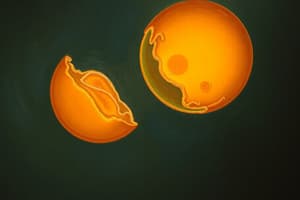Podcast
Questions and Answers
What is the primary function of reproduction in living organisms?
What is the primary function of reproduction in living organisms?
To ensure the continuation of species
What type of reproduction involves the fusion of gametes from two parents?
What type of reproduction involves the fusion of gametes from two parents?
Sexual reproduction
What is the term for the production of gametes through meiosis?
What is the term for the production of gametes through meiosis?
Gametogenesis
What type of reproductive strategy emphasizes high reproductive rates and large numbers of offspring?
What type of reproductive strategy emphasizes high reproductive rates and large numbers of offspring?
What is the term for the formation of organs and tissues from embryonic cells?
What is the term for the formation of organs and tissues from embryonic cells?
In the human male reproductive system, where is sperm stored?
In the human male reproductive system, where is sperm stored?
Where does fertilization occur in the human female reproductive system?
Where does fertilization occur in the human female reproductive system?
What is the term for the process of a fertilized egg implanting in the uterus?
What is the term for the process of a fertilized egg implanting in the uterus?
Flashcards are hidden until you start studying
Study Notes
Overview of Reproduction
Reproduction is the process by which living organisms produce offspring. It is a fundamental aspect of life, ensuring the continuation of species.
Types of Reproduction
Sexual Reproduction
- Involves the fusion of gametes (sperm and egg cells) from two parents to form a zygote
- Results in offspring with a unique combination of genetic traits from both parents
- Occurs in most eukaryotes, including animals, plants, and fungi
Asexual Reproduction
- Involves the production of offspring from a single parent without gamete fusion
- Results in offspring with identical genetic traits to the parent
- Occurs in some eukaryotes, including bacteria, archaea, and some plants and animals
Stages of Sexual Reproduction
- Gametogenesis: The production of gametes (sperm and egg cells) through meiosis
- Fertilization: The fusion of sperm and egg cells to form a zygote
- Embryogenesis: The development of the zygote into a mature individual
- Organogenesis: The formation of organs and tissues from embryonic cells
Reproductive Strategies
R-Selection
- Emphasizes high reproductive rates and large numbers of offspring
- Often seen in species with high mortality rates or unpredictable environments
K-Selection
- Emphasizes high investment in fewer, high-quality offspring
- Often seen in species with stable environments and low mortality rates
Human Reproduction
Male Reproductive System
- Produces sperm through meiosis in the testes
- Sperm is stored in the epididymis and transported through the vas deferens
Female Reproductive System
- Produces eggs through meiosis in the ovaries
- Eggs are released through the fallopian tubes and fertilized in the uterus
Fertilization and Implantation
- Fertilization occurs in the fallopian tubes, resulting in a zygote
- The zygote implants in the uterus, establishing a pregnancy
Overview of Reproduction
- Reproduction is the process by which living organisms produce offspring, ensuring the continuation of species.
Types of Reproduction
- Sexual reproduction involves the fusion of gametes (sperm and egg cells) from two parents to form a zygote, resulting in offspring with a unique combination of genetic traits from both parents.
- Asexual reproduction involves the production of offspring from a single parent without gamete fusion, resulting in offspring with identical genetic traits to the parent.
Stages of Sexual Reproduction
- Gametogenesis is the production of gametes (sperm and egg cells) through meiosis.
- Fertilization is the fusion of sperm and egg cells to form a zygote.
- Embryogenesis is the development of the zygote into a mature individual.
- Organogenesis is the formation of organs and tissues from embryonic cells.
Reproductive Strategies
- R-Selection emphasizes high reproductive rates and large numbers of offspring, often seen in species with high mortality rates or unpredictable environments.
- K-Selection emphasizes high investment in fewer, high-quality offspring, often seen in species with stable environments and low mortality rates.
Human Reproduction
Male Reproductive System
- The testes produce sperm through meiosis.
- Sperm is stored in the epididymis and transported through the vas deferens.
Female Reproductive System
- The ovaries produce eggs through meiosis.
- Eggs are released through the fallopian tubes and fertilized in the uterus.
Fertilization and Implantation
- Fertilization occurs in the fallopian tubes, resulting in a zygote.
- The zygote implants in the uterus, establishing a pregnancy.
Studying That Suits You
Use AI to generate personalized quizzes and flashcards to suit your learning preferences.




